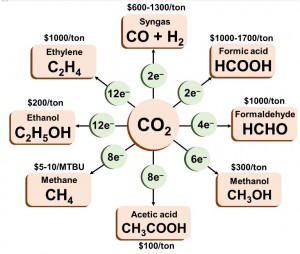CO2 utilization
Our strong reliance on fossil fuels has exponentially increased the CO2 levels in the atmosphere during the last century. One of the promising approaches to minimize CO2 emission is to convert it to added-value products and fuels using clean energy (solar, wind, and tidal).
However, the development of a sustainable technology for CO2 conversion is an extremely difficult task due to the kinetic and thermodynamic challenges of this reaction caused by the relative chemical inertness of CO2 molecule, the large number of elementary steps involved, and low intrinsic catalytic activity, selectivity, and stability of CO2-electroreduction catalysts.

CO2 electroreduction products and their current market price. The green circles indicate number of proton-coupled electron transfers required for each of these products
My research focuses on such promising alternative materials as transition metal sulfides, doped carbon, and polymer-metal hybrid materials, which are poorly explored as of yet. To identify the reaction pathway and rate-determining step, I am applying, apart from conventional electrochemical methods, advanced operando Raman spectroelectrochemical and computational modelling (Density Functional Theory) methods.
The outcomes of this work can also find applications in corrosion protection, fuel cells, sensors, and organic synthesis.
